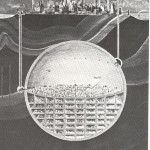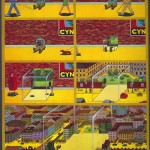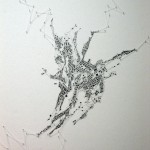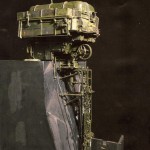A 2007 retrofuture competition, recalled on fb by Cameron Sinclair (Architecture for Humanity):
“In 2007 our NYC chapter worked with the city to develop post disaster scenarios in case the city was hit by a hurricane. Disaster preparedness matters.”
Among other predictable containers-as-shelters-solutions for an hurricane aftermath, the selected entry titled CLOUD CITY (Ostap Rudakevych, Gretchen Stump, Erik Jostock) proposes inflatable cloud homes in order for New Yorkers, to stay near their houses during reconstruction. They preview a project for phases, from construction of a unit, agglomeration of units, up until final deconstruction:
The concept for CLOUD CITY is based on the desire to allow people to remain in their community, and as close to their homes as possible. This will allow residents to remain an active part in the rebuilding of their community, while fostering a sense of security. The way to achieve this is to literally float a layer of provisional housing over the damaged or destroyed portions of Prospect Shore.
Inflatable homes would be pre-fabricated and stored in warehouses for deployment as required. Each home consists of three basic components: an inflatable bladder, a rigid core, and metal and wood platform. The bladder would consist of two compartments, filled with pressurized helium (which is non-combustible). The pressurized gas would give shape to the tailored and stitched fabric shell, creating an open living space.
Made from recycled polyester fabric, the balloon has a large surface area suitable for mounting of flexible solar panels for generating electricity. Within this living space is a rigid core which contains an efficient kitchenette and bathroom, along with plumbing and electrical services. The 300sf living space is open, and can be configured in many ways, with up to three bedroom spaces suitable for a family of four. The metal and wood platform is composed of recycled aluminum structural members, and salvaged wood flooring. It is designed to be lightweight and to facilitate storage and transport.
The homes can be rapidly deployed with minimal site preparation. Upon completion of the survey and basic infrastructure upgrades, the homes can be shipped to the site. They are intended to ‘plug in’ to existing utility services, and can be deployed by a team of four workers in roughly an hour. Once in place, access to the floating home is gained by lowering the entire home to the anchorage point (either an old rooftop, or temporary boardwalks). A keyed hand cranked winch would guide the home lower to allow for even the mobility impaired to gain easy access via the gangplank. The homes are minimally appointed, in an effort to reduce overall fabrication costs. They are fully reusable, and can be stored indefinitely.
Once airborne, the floating homes allow construction crews below to work unimpeded, speeding up the recovery effort. This in turn reduces cost overruns and unnecessary delays. Though perhaps an unusual proposal, CLOUD CITY is literally an uplifting living experience that will allow communities to remain intact as they pull themselves out of the rubble. It will provides residents with a new perspective on their community and the greater city as a whole.








Selected images from other prize-winning projects:











Respect to website author , some wonderful entropy.